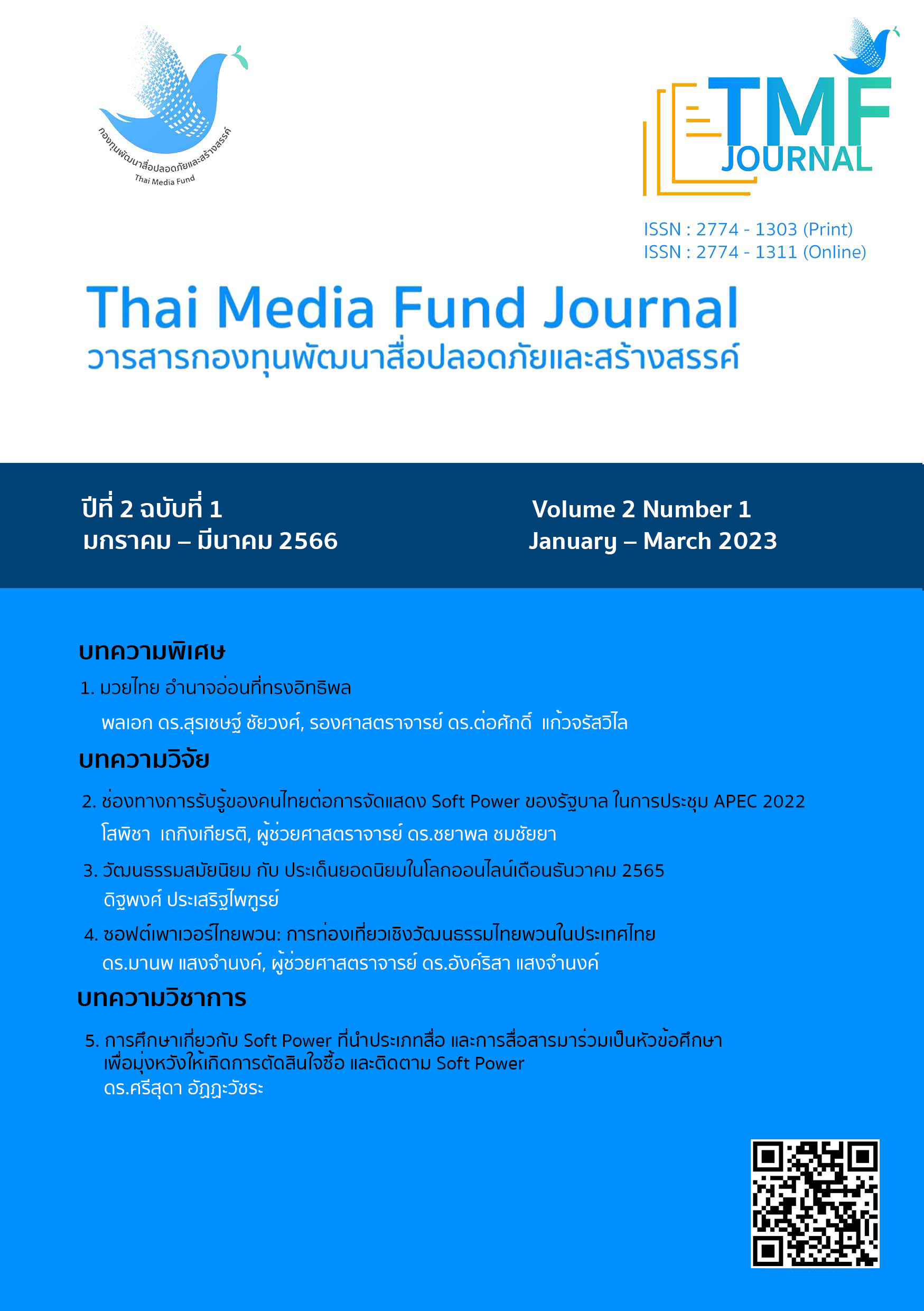วัฒนธรรมสมัยนิยม กับ ประเด็นยอดนิยมใน โลกออนไลน์เดือนธันวาคม 2565
Main Article Content
บทคัดย่อ
ปัจจุบันสื่อสังคมออนไลน์ได้รับความนิยมสูงขึ้น ทำให้ผู้คนเริ่มใช้พื้นที่สังคมออนไลน์ในการติดต่อสื่อสารกันระหว่างบุคคล นอกจากการติดต่อสื่อสารแล้ว บางครั้งสื่อสังคมออนไลน์ยังใช้ส่งต่อข้อมูลเหตุการณ์ หรือสถานการณ์สำคัญที่เกิดขึ้นในลักษณะแบบเรียลไทม์ (Real Time) ข้อมูลจาก Media Alert โดยกองทุนพัฒนาสื่อปลอดภัยและสร้างสรรค์ ได้สำรวจ 10 อันดับประเด็นยอดนิยมในโลกออนไลน์เดือนธันวาคม 2565 ที่ผ่านมา พบ 10 อันดับดังนี้ 1) การแข่งขันฟุตบอลโลก 2022 2) เรือหลวงสุโขทัยอับปาง 3) ส่งท้ายปีเก่า ต้อนรับปีใหม่ 4) คอนเสิร์ต NEO CITY: BANGKOK-THE LINK 5) นโยบายค่าแรงขั้นต่ำ 6) เทศกาลคริสต์มาส 7) อาการประชวรของ เจ้าฟ้าพัชรกิติยาภา 8) เพลง “Stand By หล่อ” 9) #นายใบเฟิร์น และ 10) จีนประกาศเปิดประเทศ จากข้อมูลดังกล่าวนี้ เมื่อนำแนวคิดในสายวัฒนธรรมศึกษามาใช้วิเคราะห์ปรากฎการณ์ที่เกิดขึ้นในครั้งนี้ พบว่าความสนใจร่วมดังกล่าวถือเป็นหนึ่งในภาพสะท้อนของ วัฒนธรรมสมัยนิยม (Pop Culture) ที่เกิดขึ้นจากคนธรรมดาสามัญโดยใช้พื้นที่โลกออนไลน์ในการสร้างเสียงพูดในสังคม เชื่อมโยงกันระหว่างวัฒนธรรมที่แตกต่างกันเข้าด้วยกัน 3 กลุ่ม ได้แก่ 1) วัฒนธรรมแฟน 2) วัฒนธรรมทางการเมืองและสถาบันทางสังคม และ 3) วัฒนธรรมสมัยนิยมที่มาจากต่างประเทศ โดยมีโลกออนไลน์เป็นตัวกลางในการสื่อสารระหว่างกลุ่มคนที่แตกต่างด้านวัฒนธรรม มาสร้างวัฒนธรรมใหม่ร่วมกัน และเกิดกลายเป็นกระแสวัฒนธรรมสมัยนิยม
Article Details

อนุญาตภายใต้เงื่อนไข Creative Commons Attribution-NonCommercial-NoDerivatives 4.0 International License.
เอกสารอ้างอิง
Chatchaiyan, P. (2020). Fan culture: An ethnographic case study of Peck Palitchoke fan club. Journal of Communication Arts, 38(2). 35-51.
Duangwises, N. (2015). The “different” of “way of thinking” towards popular culture. Retrieved from https://www.sac.or.th/databases/anthropology-concepts/articles/7
Hanpattanan, O. (2007). 104.5 Fat Radio's Teen Culture Generation. Master’s Thesis, Chulalongkorn University. Digital Research Information Center. DOI: https://doi.nrct.go.th/ListDoi/ listDetail?Resolve_DOI=10.14457/CU.the.2007.1060.
Kamput, K. (2015). A critical introduction of modern popular culture: Paradigm of culture and cultural phenomena in Southeast Asia. Journal of language and culture, 34(1).
-28.
Khanthawichai, S., Kampan, P., Phrakhruchindasaranukun, P.m, & Khamtho, S. (2022). Thai Political Culture and Participation in the Era of Connectivity. Journal of Educational Innovation and Research, 6(2). 566-578.
Media Alert. (2022). “World Cup 2022” Ranks Highest in Engagement among 4 Online Platforms December 2022. Retrieved from https://www.facebook.com/MediaAlert Thailand/photos/pcb.532595808842639/532594552176098
Muangtum, N. (2023). 16 Thai social media behavior stat & insight 2023. Retrieved from https://www.everydaymarketing.co/ trend-insight/16-thai-social-media-behavior-stat-insight-2023-from-we-are-social/
Ngamlamom, W. (2015). Popular culture. Retrieved from http://learningofpublic.blogspot.com/2015/09/popular-culture.html
Panyakaew, W., Thongyuukong, A., Sanguansak, P., & Namprai, P. (2016). Research report Thai premier league football: Gambling, masculinity, youth and popular culture. Center for Gambling Studies, Faculty of Economics, Chulalongkorn University.
Promdirake, J. (2015). Expectation, exposure, and participation in using campaign hashtags in Thailand. Master’s Thesis, Thammasat University.
Sathunuwat, P. (2019). The power of mass media in social media. Journal of Management Science Review, 21(2). 191-200.
Tianthai, J. (2020). Chulalongkorn University professor researching “Effects of social media to social and cultural changes in Thailand”. Retrieved from http://www. todayhighlightnews.com/2020/03/blog-post_31.html
Vichitrboonyaruk, P. (2011). Social media: Future media. Executive Journal, 31(4), 99-103.
Vivatananukul, M. (2014). Online social networks and intercultural communication in Thai society. Journal of Liberal Arts, Prince of Songkla University, Hat Yai Campus, 6(2). 63-78.
Wongtip, S. (2018). Social networks: The online marketing communication strategies for attracting customers in the digital age. MUT Journal of Business Administration, 15(1). 21-36.


